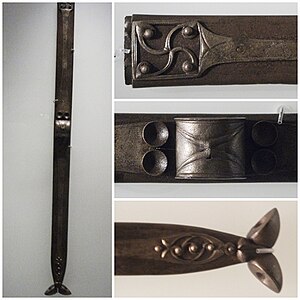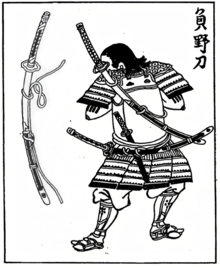Scabbard
[1] All-metal scabbards were popular items for a display of wealth among elites in the European Iron Age, and often intricately decorated.
[6] Japanese blades typically have their sharp cutting edge protected by a wooden scabbard called a saya.
[8] As late as the outbreak of World War I in August 1914, swords and leather scabbards were still being carried on active service by the military officers of participating nations.
[9] Some military police forces, naval shore patrols, law enforcement and other groups used leather scabbards as a kind of truncheon.
On the other hand, in Japan, except for some cases of the Imperial Japanese Army and Navy, water-resistant lacquered wooden scabbards have been used throughout history.
Scabbards were historically, albeit rarely, worn across the back, but only by a handful of Celtic tribes, and only with very short lengths of sword.
Common depictions of long swords being drawn from the back are a modern invention, born from safety and convenience considerations on a film set and typically enabled by creative editing, and have enjoyed such great popularity in fiction and fantasy that they are widely and incorrectly believed to have been common in Medieval times.
[11] There is some limited data from woodcuts and textual fragments that Mongol light horse archers, Chinese soldiers, Japanese samurai and European knights wore a slung baldric over the shoulder, allowing longer blades such as greatswords/zweihanders and nodachi/ōdachi to be strapped across the back, though these would have to be removed from the back before the sword could be unsheathed.





